Everyday Mathematics 2nd Grade Answer Key Unit 3 More Fact Strategies
Everyday Math Grade 2 Home Link 3.1 Answer Key
Addition Strategies
Family Note
In this lesson we learned about the making-10 strategy for adding numbers. We looked at dots arranged in two ten frames and discussed how to figure out the total number without counting each dot one by one. One way is to move dots from one frame in order to fill up the other frame to “make 10.” This strategy can make addition easier because many of us are good at adding numbers when 10 is one of them. We will revisit making 10 along with other addition strategies throughout the year.
Please return this Home Link to school tomorrow.
Question 1.
Show on the double ten frame how to use the making-10
strategy to find the total number of dots.
Then write a number model.
Number model:
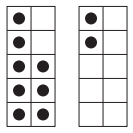
Answer:

Number Model : 8 + 2 = 10,
Explanation:
Shown on the double ten frame and made – 10
strategy in finding the total number of dots as
8 + 2 = 10, Therefore, Number Model : 8 + 2 = 10.
Question 2.
Show on the double ten frame how to use the making-10
strategy or a doubles fact to find the total number of dots.
Then write a number model.
Number model:

Answer:
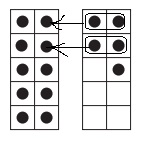
6 + 5 = 11,
Explanation:
Shown on the double ten frame and made – 10
strategy in finding the total number of dots as
6 + 5 = 11, Therefore, Number Model : 6 + 5 = 11.
Question 3.
Tell someone at home how to find the total number of dots.
Use any strategy except counting by ones.
Then write a number model.
Number model:
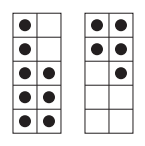
Answer:
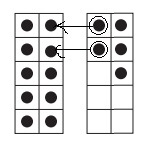
8 + 5 = 13,
Explanation:
Shown on the double ten frame and made – 10
strategy in finding the total number of dots as
8 + 5 = 13, Therefore, Number Model : 8 + 5 = 13.
Practice
Solve.
Question 4.
4 + 4 = __8_
Answer:
4 + 4 = 8,
Explanation:
Adding 4 to 4 we will get 8.
Question 5.
_14_ = 7 + 7
Answer:
14 = 7 + 7,
Explanation:
Adding 7 to 7 we will get 14.
Question 6.
4 + 5 = _9_
Answer:
4 + 5 = 9,
Explanation:
Adding 5 to 4 we will get 9.
Question 7.
_16_ = 7 + 9
Answer:
16 = 7 + 9,
Explanation:
Adding 9 to 7 we will get 16.
Everyday Math Grade 2 Home Link 3.2 Answer Key
Domino Facts
Family Note
Today we learned about related addition facts and subtraction facts.
For example, 5 + 3 = 8 has two related subtraction facts: 8 – 5 = 3 and
8 – 3 = 5. Each domino shown below can be used to
write two addition facts and two related subtraction facts.
Please return this Home Link to school tomorrow.
Write two addition facts and two subtraction facts for each domino.
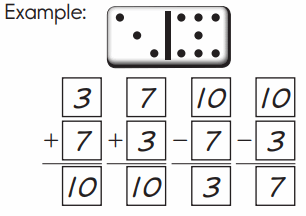
Question 1.

Answer:

Explanation:
Domino shown above shows about
two addition facts and two related subtraction facts as
Addition facts: 6 + 9 = 15, 9 + 6 = 15,
Subtraction facts: 15 – 9 = 6, 15 – 6 = 9.
Question 2.
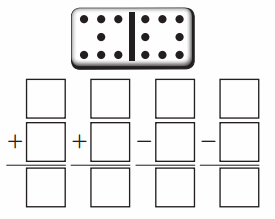
Answer:
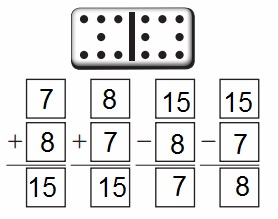
Explanation:
Domino shown above shows about
two addition facts and two related subtraction facts as
Addition facts: 7 + 8 = 15, 8 + 7 = 15,
Subtraction facts: 15 – 8 = 7, 15 – 7 = 8.
Question 3.
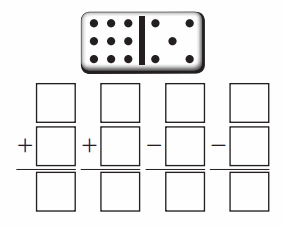
Answer:

Explanation:
Domino shown above shows about
two addition facts and two related subtraction facts as
Addition facts: 9 + 5 = 14, 5 + 9 = 14,
Subtraction facts: 14 – 9 = 5, 14 – 5 = 9.
Facts Practice
Fill in the unit box. Solve the problems.
Question 4.
7 + 3 = _10_
Answer:
7 + 3 = 10,
Explanation:
Adding 3 to 7 we will get 10.
Question 5.
_12_ = 7 + 5
Answer:
12 = 7 + 5,
Explanation:
Adding 5 to 7 we will get 12.
Question 6.
6 + 4 = _10_
Answer:
6 + 4 = 10,
Explanation:
Adding 4 to 6 we will get 10.
Question 7.
6 + 5 = _11_
Answer:
6 + 5 = 11,
Explanation:
Adding 5 to 6 we will get 11.
Everyday Math Grade 2 Home Link 3.3 Answer Key
Fact Triangles
Cut out the Fact Triangles. Show someone at home how
you use them to practice adding and subtracting.


Adding Subtracting
1. 2 + 3 = 5, 5 – 3 = 2,
2. 2 + 4 = 6, 6 – 4 = 2,
3. 2 + 5 = 7, 7 – 5 = 2,
4. 2 + 6 = 8, 8 – 6 = 2,
5. 2 + 7 = 9, 9 – 7 = 2,
6. 2 + 8 = 10, 10 – 8 = 2,
7. 2 + 9 = 11, 11 – 9 = 2,
8. 2 + 10 = 12, 12 – 2 = 10,
9. 3 + 10 = 13, 13 – 3 = 10,
10. 4 + 10 = 14, 14 – 4 = 10,
11. 5 + 10 = 15, 15 – 5 = 10,
12. 6 + 10 = 16, 16 – 6 = 10,
13. 7 + 10 = 17, 17 – 7 = 17,
Explanation:
Cutted the Fact Triangles as shown above,
added and subtracted the fact triangles as
Adding Subtracting
1. 2 + 3 = 5, 5 – 3 = 2,
2. 2 + 4 = 6, 6 – 4 = 2,
3. 2 + 5 = 7, 7 – 5 = 2,
4. 2 + 6 = 8, 8 – 6 = 2,
5. 2 + 7 = 9, 9 – 7 = 2,
6. 2 + 8 = 10, 10 – 8 = 2,
7. 2 + 9 = 11, 11 – 9 = 2,
8. 2 + 10 = 12, 12 – 2 = 10,
9. 3 + 10 = 13, 13 – 3 = 10,
10. 4 + 10 = 14, 14 – 4 = 10,
11. 5 + 10 = 15, 15 – 5 = 10,
12. 6 + 10 = 16, 16 – 6 = 10,
13. 7 + 10 = 17, 17 – 7 = 17.
Cut out the Fact Triangles. Show someone at home how
you use them to practice adding and subtracting.
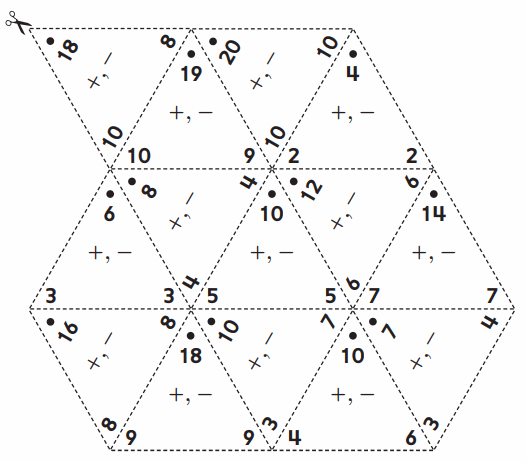
Answer:
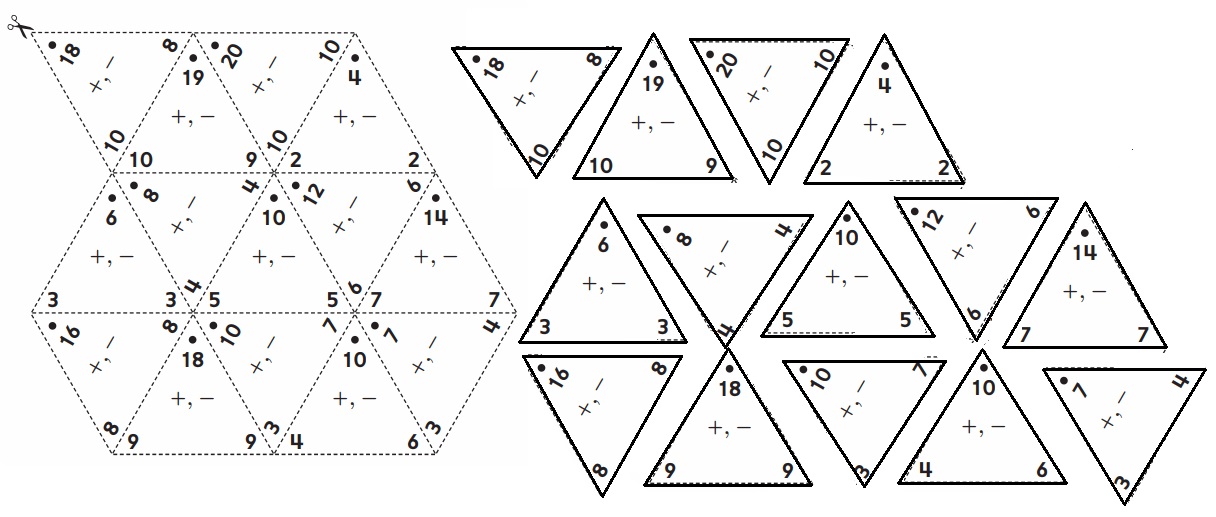
Adding Subtracting
1. 10 + 8 = 18, 18 – 8 = 10,
2. 10 + 9 = 19, 19 – 9 = 10,
3. 10 + 10 = 20, 20 – 10 = 10,
4. 2 + 2 = 4, 4 – 2 = 2,
5. 3 + 3 = 6, 6 – 3 = 3,
6. 4 + 4 = 8, 8 – 4 = 4,
7. 5 + 5 = 10, 10 – 5 = 5,
8. 6 + 6 = 12, 12 – 6 = 6,
9. 7 + 7 = 14, 14 – 7 = 7,
10. 8 + 8 = 16, 16 – 8 = 8,
11. 9 + 9 = 18, 18 – 9 = 9,
12. 7 + 3 = 10, 10 – 3 = 7,
13. 6 + 4 = 10, 10 – 4 = 6,
14. 4 + 3 = 7, 7 – 3 = 4,
Explanation:
Cutted the Fact Triangles as shown above,
added and subtracted the fact triangles as
Adding Subtracting
1. 10 + 8 = 18, 18 – 8 = 10,
2. 10 + 9 = 19, 19 – 9 = 10,
3. 10 + 10 = 20, 20 – 10 = 10,
4. 2 + 2 = 4, 4 – 2 = 2,
5. 3 + 3 = 6, 6 – 3 = 3,
6. 4 + 4 = 8, 8 – 4 = 4,
7. 5 + 5 = 10, 10 – 5 = 5,
8. 6 + 6 = 12, 12 – 6 = 6,
9. 7 + 7 = 14, 14 – 7 = 7,
10. 8 + 8 = 16, 16 – 8 = 8,
11. 9 + 9 = 18, 18 – 9 = 9,
12. 7 + 3 = 10, 10 – 3 = 7,
13. 6 + 4 = 10, 10 – 4 = 6,
14. 4 + 3 = 7, 7 – 3 = 4.
Everyday Math Grade 2 Home Link 3.4 Answer Key
Finding Missing Addends
Family Note
In this lesson children played Salute! to practice finding missing addends, which helps them develop fluency with basic facts. Children may solve missing-addend problems by subtracting, counting up, or counting back. Salute! is played with three players and a deck of cards. Remove the face cards and jokers before you begin.
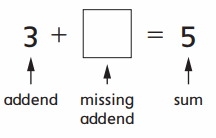
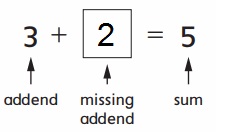
Explanation:
Given addend + Missing addend = sum as
3 + __ = 5, therefore the missing addend is
5 – 3 = 2 as shown above.
Directions
1. One person is selected as the dealer. The dealer gives one card to each of the other two players.
2. Without looking at their cards, players hold them on their foreheads with the number facing out.
3. The dealer looks at both cards and says the sum of the two numbers.
4. Each player looks at the other player’s card, keeping in mind the sum said by the dealer. The
object is for the players to figure out the number on their own card and say it aloud.
5. After both players have said their numbers, they can look at their own cards.
6. Rotate roles and repeat the game.
7. Play continues until all cards have been used or each player has been the dealer five times.
Please return this Home Link to school tomorrow.
Find the missing addends for the rounds of Salute!
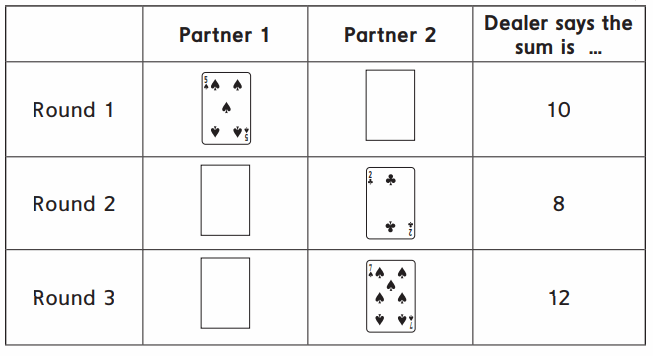
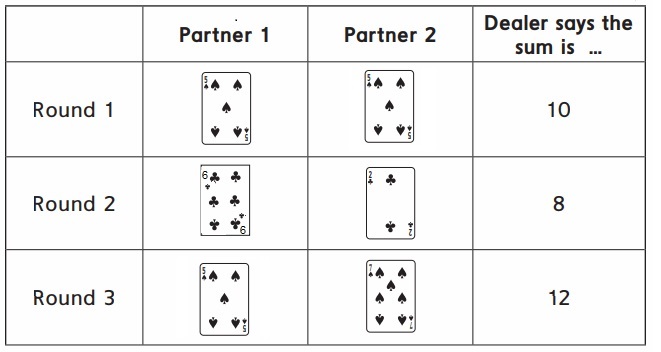
Explanation:
The missing addends for the rounds of Salute are
Round 1 : 5 + ____ = 10, therefore missing addends is
10 – 5 = 5.
Round 2 : ___ + 2 = 8, therefore missing addends is
8 – 2 = 6.
Round 3 : ___ + 7 = 12, therefore missing addends is
12 – 7 = 5 as shown above respectively.
Everyday Math Grade 2 Home Link 3.5 Answer Key
Counting Up and Counting Back
Family Note
Today we learned about two subtraction strategies: counting up and counting back. We can use the counting-up strategy when the numbers in a subtraction problem are close together. For example, to solve 11 – 9 it is easier to start at 9 and count up to 11. This takes 2 counts (9 to 10 and 10 to 11), so the answer is 2. When the number being subtracted is small, the counting-back strategy is easier.
For example, to solve 12 – 3 it is easier to start at 12 and count back 3 (12 to 11, 11 to 10, and 10 to 9). We end on 9, so the answer is 9.
Please return this Home Link to school tomorrow.
Use the counting-up strategy to solve.
Question 1.
7 – 4 = _3_
Answer:
7 – 4 = 3,
Explanation:
To solve 7 – 4 it is easier to start at 4 and
count up to 7. This takes 3 counts (4 to 5, 5 to 6 and
6 to 7), so the answer is 3.
We used the counting-up strategy as the numbers
in a subtraction problem are close together.
Question 2.
9 – 7 = _2_
Answer:
9 – 7 = 2,
Explanation:
To solve 9 – 7 it is easier to start at 7 and
count up to 9. This takes 2 counts (7 to 8 and 8 to 9),
so the answer is 2.
We used the counting-up strategy as the numbers
in a subtraction problem are close together.
Question 3.
11 – 8 = _3_
Answer:
11 – 8 = 3,
Explanation:
To solve 11 – 8 it is easier to start at 8 and
count up to 11. This takes 3 counts (8 to 9, 9 to 10 and
10 to 11), so the answer is 3.
We used the counting-up strategy as the numbers
in a subtraction problem are close together.
Question 4.
13 – 11 = _2_
Answer:
13 – 11 = 2,
Explanation:
To solve 13 – 11 it is easier to start at 11 and
count up to 13. This takes 2 counts ( 11 to 12 and 12 to 13),
so the answer is 2.
We used the counting-up strategy as the numbers
in a subtraction problem are close together.
Use the counting-back strategy to solve.
Question 5.
9 – 2 = _7_
Answer:
9 – 2 = 7,
Explanation:
To solve 9 – 2 it is easier to start at 9 and count back 2
(9 to 8 and 8 to 7). We end on 7, so the answer is 7.
As the number being subtracted is small,
so the counting-back strategy is easier.
Question 6.
12 – 3 = _9_
Answer:
12 – 3 = 9,
Explanation:
To solve 12 – 3 it is easier to start at 12 and count back 3
(12 to 11, 11 to 10 and 10 to 9). We end on 9, so the answer is 9.
As the number being subtracted is small,
so the counting-back strategy is easier.
Question 7.
14 – 2 = _12__
Answer:
14 – 2 = 12,
Explanation:
To solve 14 – 2 it is easier to start at 14 and count back 2
(14 to 13 and 13 to 12). We end on 12, so the answer is 12.
As the number being subtracted is small,
so the counting-back strategy is easier.
Question 8.
15 – 4 = _11_
Answer:
15 – 4 = 11,
Explanation:
To solve 15 – 4 it is easier to start at 15 and count back 4
(15 to 14, 14 to 13, 13 to 12 and 12 to 11).
We end on 11, so the answer is 11.
As the number being subtracted is small,
so the counting-back strategy is easier.
Write “counting up” or “counting back” on the line.
Question 9.
To solve 13 – 9, _Counting up__ is faster.
Answer:
13 – 9 = 4, Counting up is faster,
Explanation:
To solve 13 – 9 it is easier to start at 9 and
count up to 13. This takes 4 counts (9 to 10, 10 to 11,
11 to 12 and 12 to 13), so the answer is 4.
We used the counting-up strategy as the numbers
in a subtraction problem are close together.
Question 10.
To solve 13 – 2, __Counting back_ is faster.
Explain your answer.
Answer:
13 – 2 = 11, Counting back is faster,
Explanation:
To solve 13 – 2 it is easier to start at 13 and count back 2
(13 to 12 and 12 to 11). We end on 11, so the answer is 11.
As the number being subtracted is small,
so the counting-back strategy is easier.
Practice
Write the turn-around fact for each addition fact.
Question 11.
7 + 6 = 13___
Answer:
Turn-around fact: 6 + 7 = 13,
Explanation:
Given 7 + 6 = 13, the turn-around fact
or reverse the addends or factors for 7 + 6 = 13 is
6 + 7 = 13 and we got the same answer as 13.
Question 12.
4 + 8 = 12 ___
Answer:
Turn-around fact: 8 + 4 = 12,
Explanation:
Given 4 + 8 = 12, the turn-around fact
or reverse the addends or factors for 4 + 8 = 12 is
8 + 4 = 12 and we got the same answer as 12.
Everyday Math Grade 2 Home Link 3.6 Answer Key
Family Note
In today’s lesson children explored the – 0 (minus 0) and – 1 (minus 1) fact strategies:
• If 0 is subtracted from any number, that number doesn’t change.
Examples: 3 – 0 = 3 and 27 – 0 = 27
• If 1 is subtracted from any number, the result is the next smaller number.
Examples: 7 – 1 = 6 (6 is the next smaller number) and 48 – 1 = 47 (47 is the next smaller number)
Children also played Subtraction Top-It to practice using subtraction strategies. They will be exposed to various strategies throughout the year to help develop fluency with subtraction facts.
Please return this Home Link to school tomorrow.
Solve.
Question 1.
8 – 1 = _7_
Answer:
8 – 1 = 7,
Explanation:
As 1 is subtracted from 8, So the result is
the next smaller number 7 as 8 – 1 = 7.
Question 2.
_11_ = 11 – 0
Answer:
11 = 11 – 0,
Explanation:
As 0 is subtracted from 11 number,
the number doesn’t change, so 11 – 0 = 11.
Question 3.
9 – 1 = _8_
Answer:
9 – 1 = 8,
Explanation:
As 1 is subtracted from 9, So the result is
the next smaller number 8 as 9 – 1 = 8.
Question 4.
12 – _0_ = 12
Answer:
12 = 12 – 0,
Explanation:
As 0 is subtracted from 12 number,
the number doesn’t change, so 12 – 0 = 12.
Question 5.
13 – 1 = _12_
Answer:
13 – 1 = 12,
Explanation:
As 1 is subtracted from 13, So the result is
the next smaller number 12 as 13 – 1 = 12.
Question 6.
_9_ = 10 – 1
Answer:
9 = 10 – 1,
10 – 1 = 9,
Explanation:
As 1 is subtracted from 10, So the result is
the next smaller number 9 as 10 – 1 = 9.
Practice
Solve.
Question 7.
5 + 5 = _10_
Answer:
5 + 5 = 10,
Explanation:
Adding 5 to 5 we will get 10.
Question 8.
5 + 7 = _12_
Answer:
5 + 7 = 12,
Explanation:
Adding 7 to 5 we will get 12.
Question 9.
_18_ = 9 + 9,
Answer:
18 = 9 + 9,
Explanation:
Adding 9 to 9 we will get 18.
Question 10.
_17_ = 8 + 9
Answer:
17 = 8 + 9,
Explanation:
adding 9 to 8 we will get 17.
Everyday Math Grade 2 Home Link 3.7 Answer Key
“What’s My Rule?”
Give the Family Note to someone at home. Show that person how you can complete “What’s My Rule?” tables. Show that person how you can find rules.
Question 1.
Fill in the table.
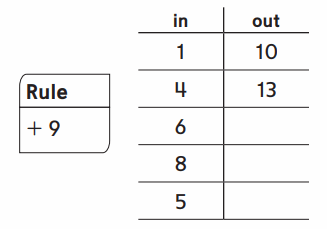
Answer:
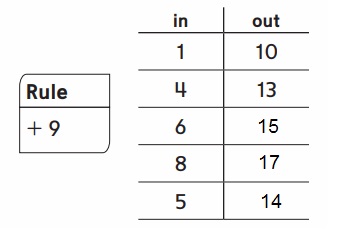
Explanation:
Given rule is + 9 , so in 1 means out will be 1 + 9 = 10,
in 4 means out will be 4 + 9 = 13,
if in is 6 means out will be 6 + 9 = 15,
if in is 8 means out will be 8 + 9 = 17,
if in is 5 means out will be 5 + 9 = 14.
Question 2.
Fill the rule.
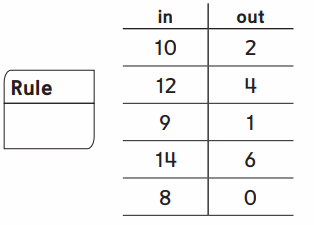
Answer:

Explanation:
Given in 10 and out 2 means 10 – 2 = 8,
in 12 and out 4 means 12 – 4 = 8,
in 9 and out 1 means 9 – 1 = 8,
in 14 and out 6 means 14 – 6 = 8,
in 8 and out 0 means 8 – 0 = 8, therefore
rule is -8 respectively.
Question 3.
Fill in the table
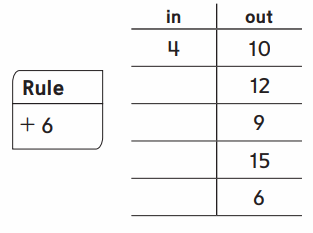
Answer:
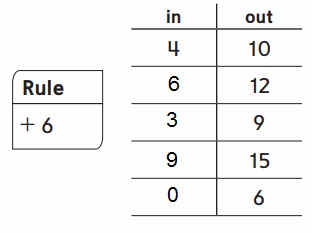
Explanation:
Given out 10 and rule +6 means in is 10 -6 = 4,
out 12 and rule + 6 means in is 12 – 6 = 6,
out 9 and rule + 6 means in is 9 – 6 = 3,
out 15 and rule + 6 means in is 15 – 6 = 9,
out 6 and rule + 6 means in is 6 – 6 = 0 respectively.
Question 4.
Fill the rule and fill in the missing in and out numbers.

Answer:

Explanation:
Given in 8 and out 13 means 13 – 8 = 5, so rule +5
in 4 and out 9 means 9 – 4 = 5, so rule + 5,
in 13 and out is 13 + 5 = 18 by applying rule + 5,
given out 10 so in will be 10 – 5 = 5 by applying rule +5,
by applying rule + 5 in will be 2 means out will be 2 + 5 = 7.
Everyday Math Grade 2 Home Link 3.8 Answer Key
Finding Missing Addends
Family Note
In this lesson children learned about using doubles facts to help solve subtraction facts. This is a strategy children can use whenever a subtraction fact is related to an addition double or to an addition fact close to a double. To solve 8 – 4 = _4__, children might think of the related addition double 4 + 4 = 8 to find the answer 4. To solve 15 – 8 = _8_, children could think 8 + _7_ = 15. Starting from the double 8 + 8 = 16, they will find the solution is 1 less than 8, or 7.
Please return this Home Link to school tomorrow
Look at the missing addend in each Fact Triangle. Tell someone at home how to use doubles to help find it.

Question 1.
Explain how you found the missing addend.

Answer:

13 – 6 = 7,
Explanation:
I know 6 + 6 =12 and
13 is more 1 than 12. So I added 1 to
one of the 6s. So answer is 7.
Question 2.
Explain how you found the missing addend.
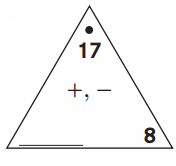
Answer:
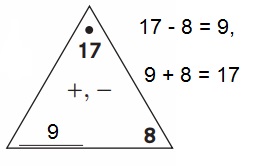
17 – 8 = 9,
Explanation:
I know 8 + 8 =16 and
17 is more 1 than 16. So I added 1 to
one of the 8s. So answer is 9.
Practice
Solve.
Question 3.
8 + 2 = _10_
Answer:
8 + 2 = 10,
Explanation:
Given to find 8 + 2 = ,
So adding 2 to 8 we will get 10.
Question 4.
8 + 3 = _11_
Answer:
8 + 3 = 11,
Explanation:
Given to find 8 + 3 = ,
So adding 3 to 8 we will get 11.
Everyday Math Grade 2 Home Link 3.9 Answer Key
Subtraction Strategy: Going Back Through 10
Family Note
In today’s lesson your child learned a subtraction strategy called going back through 10. Because 10 is a friendly number that children are comfortable working with, children break the subtraction into two steps, using 10 as a breaking point. To solve 12 – 5 = ? your child may say:
• Start from 12, take away 2 to get to 10, and then take away 3 more to get to 7. By taking away the two parts 2 and 3, I get to 7. So the answer is 12 – 5 = 7.

Your child may choose to use a different strategy to subtract, but it’s important to expose him or her to various strategies. Help your child solve the problems below by going back through 10.
Please return this Home Link to school tomorrow.
Solve each problem using the going-back-through-10 strategy. Use the number line to show your work. Then explain your thinking.
Question 1.
13 – 4 = _9_


Explanation:
Given 13 – 4 =
Starting from 13, take away 3 we will get to 10 and
then take away 1 more I will get to 9.
By taking away the two parts 3 and 1 = 4,
I will get to 9. So the answer is 13 – 4 = 9.
Question 2.
15 – 7 = _8_


Explanation:
Given 15 – 7 =
Starting from 15, take away 5 we will get to 10 and
then take away 2 more I will get to 8.
By taking away the two parts 5 and 2 = 7,
I will get to 8. So the answer is 15 – 7 = 8.
Explain how you solved Problems 1−2 to someone at home.
Practice
Write the turn-around fact.
Question 3.
3 + 5 = 8 __
Answer:
Turn around fact : 5 + 3 = 8,
Explanation:
Given 3 + 5 = 8, the turn-around fact
or reverse the addends or factors for 3 + 5 = 8 is
5 + 3 = 8 and we got the same answer as 8.
Explanation:
Question 4.
15 = 9 + 6 ___
Answer:
Turn around fact : 15 = 6 + 9,
Explanation:
Given 9 + 6 = 15, the turn-around fact
or reverse the addends or factors for 9 + 6 = 15 is
6 + 9 = 15 and we got the same answer as 15.
Everyday Math Grade 2 Home Link 3.10 Answer Key
Going-Through-10 Strategies
Family Note
In today’s lesson your child learned a subtraction strategy called going up through 10. This strategy is similar to the going-back-through-10 strategy your child learned in Lesson 3-9. Children use 10 as a friendly number to solve subtraction facts, but they go up instead of back.
To solve 13 – 8 = ? your child may say the following:
• Start from 8. Go up to 10, which is 2. Then go up to 13, which is 3 more. By adding together the two parts 2 and 3, I get 5. So the answer is 13 – 8 = 5.

Your child might use a different strategy to subtract, but it’s important to expose him or her to a variety of strategies. Parents can help children by guiding them to solve problems using the going-up-through-10 strategy and asking them to explain what they are thinking as they use it.
Please return this Home Link to school tomorrow.
Solve each problem using the going-up-through-10 strategy. Use the number line to show your work. Then explain your thinking to someone at home.
Question 1.
11 – 5 = _6_

Answer:

Explanation:
Given 11 – 5 = 6,
Starting from 5. Going up to 10, which is 5. Then going
up to 11 which is 1 more. By adding together the
two parts 5 and 1, I will get 6. So the answer is 11 – 5 = 6.
Question 2.
13 – 6 = _7_

Answer:

Explanation:
Given 13 – 6 = 7,
Starting from 6. Going up to 10, which is 4. Then going
up to 13 which is 3 more. By adding together the
two parts 4 and 3, I will get 7. So the answer is 13 – 6 = 7.
Practice
Solve.
Question 3.
_12_ = 6 + 6
Answer:
12 = 6 + 6,
Explanation:
Given 6 + 6 =, so adding 6 to 6 we will get 12.
Question 4.
9 + 1 = _10_
Answer:
9 + 1 = 10,
Explanation:
Given 9 + 1 = , so adding 9 to 1 we will get 10.
Question 5.
_14_ = 6 + 8
Answer:
14 = 6 + 8,
Explanation:
Given 6 + 8 = , so adding 8 to 6 we will get 14.
Everyday Math Grade 2 Home Link 3.11 Answer Key
Counting Coins
Family Note
In this activity your child will count combinations of coins and write each group’s value. Children have learned to count coins in order of value: they count quarters first, then dimes, then nickels, and finally pennies. Your child will also draw coins to show different ways to make a certain amount of money. For example, your child might show 28¢ with 1 quarter and 3 pennies or with 2 dimes, 1 nickel, and 3 pennies. You might provide real coins for your child to use for this Home Link.
Please return this Home Link to school tomorrow.
In Problems 1–3, write the total amount.
Question 1.

Answer:
Total amount = 33¢,
Explanation:
As we know 1 penny = 1 cent ,
A nickel = 5 cents,
A dime = 10 cents and
A quarter = 25 cents, therefore
Given picture consists of
2 pennies + 1 dime + 1 cent + 2 dimes, so
2 X 1¢ + 1 X 10¢ + 1 X 1¢ + 2 X 10¢ =
2¢ + 10¢ + 1¢ + 20¢ = 33¢,
So total amount = 33¢.
Question 2.

Answer:
Total amount = 34¢ ,
Explanation:
As we know 1 penny = 1 cent ,
A nickel = 5 cents,
A dime = 10 cents and
A quarter = 25 cents, therefore
Given picture consists of
1 penny + 1 cent + 2 dimes + 5 cents + 1 nickel + 2 cents, so
1 X 1¢ + 1 X 1¢ + 2 X 10¢ + 5 X 1¢ + 1 X 5¢ + 2 X 1¢ =
1¢ + 1¢ + 20¢ + 5¢ + 5¢ + 2¢ = 34¢,
So total amount = 34¢.
Question 3.

Answer:
Total amount = 52¢,
Explanation:
As we know 1 penny = 1 cent ,
A nickel = 5 cents,
A dime = 10 cents and
A quarter = 25 cents, therefore
Given picture consists of
1 dime + 1 dime + 1 quarter + 1 nickel + 1 cent + 1 penny so
1 X 10¢ + 1 X 10¢ + 1 X 25¢ + 1 X 5¢ + 1 X 1¢ + 1 X 1¢ =
10¢ + 10¢ + 25¢ + 5¢ + 1¢ + 1¢ = 52¢, So Total amount = 52¢.
Question 4.

Answer:

Explanation:
As we know 1 penny = 1 cent ,
A nickel = 5 cents,
A dime = 10 cents and
A quarter = 25 cents, therefore
different ways to make 57¢ are:
1. 1 quarter + 1 quarter + 1 nickel + 2 pennies =
25¢ + 25¢ + 5¢ + 2¢ = 57¢ or
2. 5 dimes + 7 pennies =
5 X 10 cents = 50¢ so 50¢ + 7¢ = 57¢ as shown above.